Africa is located in the Cusp of the Tourist Renaissance. With its extraordinary natural beauty, cultural diversity and vast coastline, the continent is ready to become one of the most exciting cruise destinations in the world. Now is the time to turn long-standing possibilities into lasting advancements. Cruise tourism is one of the paths to achieving this.

As Managing Director of MSC Cruises South Africa, I have seen how cruising can provide valuable travel experiences and act as a catalyst for economic growth, job creation and regional development. Through collaboration and investment, the full value of cruise tourism across Africa can be unlocked.
Coastline of Opportunity
Over 30,000km of Africa's coastline spans vibrant cities, pristine beaches and diverse ecosystems, from the Indian Ocean to the Atlantic Ocean. Ports such as Cape Town, Durban, Guqueberja, Richards Bay, Maputo and Walvis Bay are already welcoming cruise ships and providing facilities for service ships. These destinations demonstrate the potential to exist and lay the foundation for future growth.
We look forward to the upcoming 2025/26 season, with MSC Opera returning to South African waters, expanding to destinations such as Port Louis, and expanding to Mamoudzou, the Comorian Islands for the first time. These itineraries reflect the growing appeal of coastal cruises in Africa and what can be done when a shared vision of tourism development is accepted.
Laying the foundation for growth
We recognize the importance of overall infrastructure development for the industry to flourish. Modern ships can carry up to 10,000 people (passengers and crew) representing greater economic opportunities, but many African cities need to strengthen their ability to handle tourism of this size.
A well-equipped port is essential, but a quality cruise experience also relies on seamless airport connections, modern roads, efficient service and memorable inland excursions. For example, Durban offers easy access to highlights such as Hluhluwe and Drakensberg.
Equally important are leisure activities that make your destination memorable. From snorkeling at Crystal Clearwaters to exploring world heritage sites to enjoying local cuisine, music and cultural experiences, these opportunities create lasting memories for visitors while supporting local businesses. Whether you're a township tour in Gqeberha, a visit to Spice Market in Port Louis, or a Sunset Dow Cruise in Maputo, an excursion will help connect travelers to the centre of their destinations.
Cross-sector collaboration is essential to realizing the possibilities of cruise tourism. Partnerships between port authorities, tourism boards, local governments, hotels, transportation operators and activity providers will help align the efforts with broader development goals. By creating cruise-enabled cities that act as gateways to inland adventures and cultural experiences, you can create lasting value for both the local community and visitors.
Enriching and empowering tourism
Sustainable growth is an important focus. From adopting cleaner fuel technology and advanced waste management systems to efficient itinerary, environmental responsibility is increasingly embedded in cruise operations.
Equally important is the possibility that cruise tourism can raise the community. By prioritizing partnerships with local guides, artisans and entrepreneurs, we ensure that each suspension on the cruise route contributes to job creation, cultural exchange and the growth of small and medium-sized businesses.
Training and enterprise support allow communities to become active participants in the tourism economy, creating authentic and meaningful experiences for visitors while expanding opportunities at home.
Work together for successful sharing
A notable aspect of Africa's cruise tourism journeys is the heightened spirit of collaboration. Globally, successful cruise destinations are built on a coordinated strategy between public and private stakeholders. Africa is no exception. From co-marketing to infrastructure development, there are unique opportunities to leverage the power of partnerships.
Regional cooperation can further this. Multi-country cruise itinerary offers unparalleled varieties, streamlines the visa process, harmonizes standards, and collaborates to co-employ the cruise corridor, allowing African countries to create interconnected cruise experiences that bring all their benefits.
A bright future in sight
The global cruise industry has already shown the potential for that change. For example, the Florida cruise sector has donated more than $168 billion to its economy. All regions are unique, but Africa can also chart their own courses. Already, tourism has donated 8.8% to South Africa's GDP, with room for growth. Looking at the achievements of fellow peers like Morocco and Greece reveals the possibility.
In Morocco and Greece, strategic investments, coordinated marketing and public-private partnerships have revitalized coastal towns into lively cruise destinations. While Casablanca and Tangier have become gateways to cultural experiences, Greek islands offer itineraries filled with historical, culinary and natural beauty. These examples illustrate how infrastructure and partnerships can be positioned as cruise tourism as drivers of inclusive growth, job creation and international visibility. This is a model for South Africa and the Continent.
This is a moment of opportunity. Africa can combine innovation, sustainability and cultural connections to establish itself as a major cruise destination with its comprehensive policy, investment and shared commitment to inclusive development.
This conversion is not only possible, but is already in progress. Through collective efforts, the future of tourism in Africa can be unlocked and shaped for future generations.


